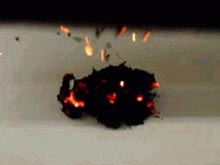
Camera Flash Ignites Carbon Nanotubes: New Research Insights

It sounds like a photographer’s worst nightmare: the light of the flashbulb causes the subject of the photo to burst into flames. But that’s exactly what happened recently when researchers snapped a picture of some single-walled carbon nanotubes, tiny cylinders of pure carbon. The findings, described in a report published in the current issue of the journal Science, suggest that the minute straws could be used as triggering devices or for remote light-induced ignition.
The discovery was made by accident, when an undergraduate in Pulickel Ajayan’s laboratory at the Rensselaer Polytechnic Institute took some flash photographs as part of a different research project. “The single-walled carbon nanotube samples in this situation were just a jumble of tubes,” Ajayan recalls. “They were not laid out in any pattern, and because of that, the heat generated from the flash could not dissipate, so the nanotubes just burned.” Ajayan and his colleagues note in their report that only single-walled carbon nanotubes react to flash light in this explosive manner, emitting a loud pop before igniting [see image]. Because extensive rearrangement of the carbon atoms occurs, the scientists estimate that the tubes reach temperatures of nearly 1,500 degrees Celsius. Interestingly, if the single-walled straws are exposed to a camera flash in an environment devoid of oxygen, they do not burn, but their atomic structure is still altered.
The work adds to the ever growing list of unique characteristics of the tiny carbon cylinders. Their fortuitous discovery has not yet been put to work, but study co-author Ganapathiraman Ramanath of Rensselaer has plenty of ideas. “From an applications perspective, our work opens up exciting possibilities of using low-power light sources to create new forms of nanomaterials,” he says, “and will serve as a starting point for developing nanotube-based actuators and sensors that rely on remote activation and triggering.”












